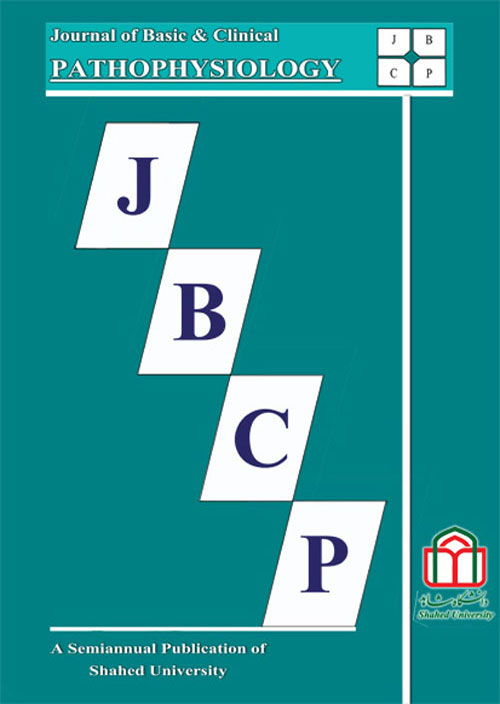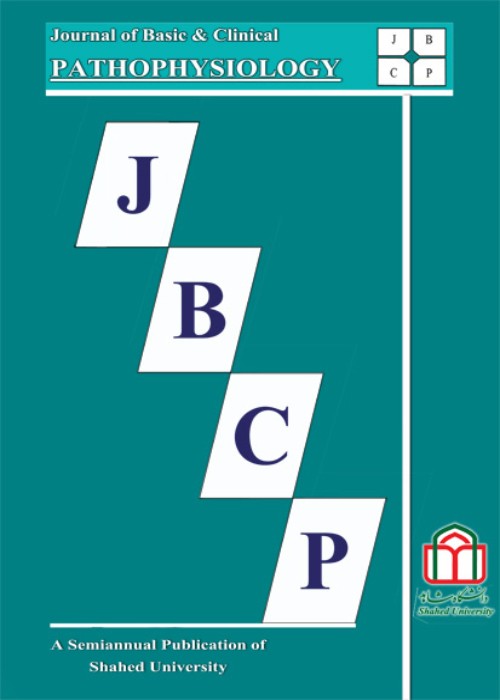فهرست مطالب

Journal of Basic & Clinical Pathophysiology
Volume:8 Issue: 2, Summer-Autumn 2020
- تاریخ انتشار: 1399/11/13
- تعداد عناوین: 8
-
-
Pages 1-6Objective
The aim of this study was to evaluate the effect of citalopram on the prevention of migraine headaches as compared to placebo.
Materials and MethodsThis double-blind randomized clinical trial was conducted on patients diagnosed with migraine headaches based on the guidelines of the International Headache Society. 226 patients who met inclusion criteria were randomly allocated to two control and intervention groups. The treatment group was treated with citalopram 30 mg daily for two months and the control group was given placebo the same amount as the treatment group. All the patients were assessed at the beginning of the trial and after 1 month and 2 months and the frequency, severity and duration of their headaches were documented using the Visual Analogue Scale (VAS) and Behavioral Rating Scale (BRS-6). Data were analyzed using SPSS v.16 software.
ResultsEven though initially there was no statistically significant difference between the two groups regarding the severity, duration and frequency of episodes of migraine (P>0.05), the same parameters had drastic changes after the first and second months of treatment and the differences between the citalopram and placebo group regarding severity, duration and frequency of migraine episodes were statistically significant (P<0.05).
ConclusionThe outcome of this experiment showed that citalopram, a serotonin uptake inhibitor (SSRI), possibly through a serotonin-lowering mechanism, results in less exposure of the CNS to this agent, leading to less frequent, less severe and shorter migraine episodes. This medication appears to be useful as a preventive drug used to treat and maintain episodes of migraine headaches, especially in individuals suffering from both migraine headaches and clinical depression.
Keywords: Migraine Headache, Citalopram, Serotonin Uptake Inhibitors, prevention -
Pages 7-14Background and ObjectivePain is a physiologic protective function with regard to external or internal harmful stimulus or tissue damage. The aim of the current study was to determine anti-nociceptive activity of Melilotus officinalis (Linn.) extract on formalin-induced pain in mice.Materials and MethodsIn experiment 1, adult male mice were injected (i.p) with saline, ethanoic extract of Melilotus officinalis (Linn.) (EEMO) (100, 200 and 400 mg/kg) or morphine (5 mg/kg). In experiment 2, mice were injected with saline, EEMO (400 mg/kg), naloxone (2 mg/kg) and co-injection of EEMO (400 mg/kg) + naloxone (2 mg/kg). In experiment 3, animal received i.p injection of saline, EEMO (400 mg/kg), L-NAME (10 mg/kg) and EEMO (400 mg/kg) + L-NAME (10 mg/kg). In experiment 4, mice were injected (i.p) with saline, EEMO (400 mg/kg), atropine (1 mg/kg) and co-administration of EEMO (400 mg/kg) + atropine (1 mg/kg). Then, the time spent for paw licking was determined the in first and second phase after formalin injection. Then, licking and biting time of the injected paw was recorded after formalin injection in first and second phases.ResultsAccording to the results, EEMO in a dose dependent manner significantly diminished licking and biting time of injected paw (pain response) in comparison with the control group (P<0.05). Co-injection of the naloxone + EEMO significantly amplified pain response compared to the EEMO group (P<0.05). Co-injection of the L-NAME + EEMO significantly decreased pain response in comparison with the EEMO group (P<0.05). Pretreatment with atropine significantly enhanced pain response in comparison with the EEMO group (P<0.05).ConclusionThese findings suggest that anti-nociceptive activity of the EEMO is mediated via opioidergic, nitrergic and muscarinergic systems in mice.Keywords: Anti-nociceptive, Melilotus officinalis (Linn.), mice
-
Pages 15-21Background and ObjectiveDespite the massive use of costly models, our understanding of epilepsy is insignificant. We aimed to create the cost-beneficial and applicable generalized epilepsy (GE) in rats by injection of identified doses of colchicine (IDC) into the dorsal striatum of rat's brain.Materials and Methods24 male Wistar rats (290-350 g) under deep anesthesia were equipped with guide cannulae at the dorsal striatum (AP: 0.48 mm; L: 3 mm; V: 3.6). The injection cannula attached with the polyethylene tubing to the 5-µL Hamilton syringe guided daily IDC (9-25 μg,) into the dorsal striatum of rat's brain during four consecutive days. The control group only received the saline solution. At the end of the injection, the animal's behavior was investigated. Finally, all the brains were collected in 10% formalin solution and dissected out to include the striatal regions. The samples were cut coronally into 3-4 µm thick slices, embedded in paraffin, and processed by the step section technique. The slices were then stained with Hematoxylin-Eosin method and checked under the light photomicroscope for correct placement of injections as well as the possibility of lesions. The data were compared between vehicle and experimental groups by analysis of variance (ANOVA).ResultsThe findings show that GE occurs in animals receiving colchicine without significant devastation effect in the injection site in the brain of rat.ConclusionThe plant-derived alkaloid, the colchicine, aside depolymerizing of tubulin, may have an inductive effect on epilepsy in the complementary motor striatal region of the rat's brainKeywords: Generalized epilepsy, Dorsal striatum, Identified doses, Colchicine, Wistar rat
-
Pages 22-27Background and ObjectiveSafflower (Carthamus tinctorius) has a long history in traditional medicine. It contains a wide range of useful compounds such as flavonoids. In this study, the effect of safflower extract on thyroid gland activity was investigated.Materials and Methods60 male Wistar rats were studied in four groups. The negative control was left untreated while three experimental groups intra-peritoneally received 100, 200 and 300 mg/kg B.W. of safflower hydroalcoholic extract for 28 days. The serum levels of T3, T4, FT3, FT4 and TSH were measured by radioimmunoassay method on 14th and 28th days of study.ResultsThe findings showed that short-term use of the extract directly affects thyroid function as the levels of thyroid hormones are decreased significantly, whereas it has no significant effect on TSH since its mean serum concentration remained unchanged. The long-term use of this extract did not show any significant effect, confirming that during the long run, the negative feedback on the thyroid is removed and this gland becomes adapted to some effective compound (s) present in Safflower.ConclusionThe continuous short-term use of the safflower can decrease the level of thyroid hormones temporarily, while in the long term, it does not show the same effect.Keywords: Carthamus Tinctorius, Thyroid hormones, Thyroid-Stimulating Hormone, Rats
-
Pages 28-36Background and ObjectiveHeart failure (HF) is one of the most prevalent and debilitating diseases of the current era, which is the leading cause of high mortality rates in human. This study aims to investigate the simultaneous effect of crataegus supplementation and a 4-week cardiac rehabilitation program on ejection fraction (EF), blood pressure (BP), heart rate (HR), and functional capacity in patients with heart failure.Materials and Methods30 patients with heart failure (EF between 10 to 30%) with an average age of 50 to 75 voluntarily participated in the present study and randomly divided into three equal groups (n = 10), crataegus+exercise (cr+e), crataegus (cr), and control (c) groups. The cr+e and cr groups received the crataegus extract for one month. cr+e group did rehabilitation exercises for one month. The c group had their usual lifestyle and treatment without any regular exercise or supplement. Before and after the project, all subjects were tested for vital signs, (electrocardiogram) ECG, echocardiography, and a 6-minute walking test (6MWT).ResultsThe findings showed a significant increase in EF in the cr+e group after 4 weeks (p <0.00). Results of 6MWT increased after 4 weeks in cr+e and cr groups (p <0.05) and BP and HR was improved in both groups.ConclusionResults indicate that 4 weeks of exercise program along with crataegus supplement will lead to the reduction of heart risk factors in patients with heart failure by increasing the contractile strength of the heart, lowering blood pressure and improving functional capacity.Keywords: Crataegus, rehabilitation, Ejection Fraction
-
Pages 37-43Background and ObjectiveHesperetin is a citrus skin active ingredient with neuroprotective and antioxidant properties. In this study,we evaluted the therapeutic effect of hesperetin on depression and anxiety induced by reserpine injection according to behavioral tests in rats.Materials and MethodsFor this evaluation, 60 male rats weighing 230-250 mg / kg were divided into six groups, control group receiving saline for 14 days , groups receiving hesperetin (20 and 10 mg / kg for 7 days) , depressed group with reserpine (0.2 mg / kg for 14 days) and depressed groups receiving hesperetin (20 and 10 mg / kg for 7 days). After taking the drugs, the effect of hesperetin was evaluated in behavioral tests.on depression and anxiety.ResultsThe results showed that hesperetin significantly reduced the anxiety of depressed animals in Open Field and Elevated Plus Maze Tests (P <0.05). In Forced Swimming Test, hesperetin 20 mg / kg caused a significant decrease in immobility time (P <0.001), and also, hesperetin could decrease the immobility time in depressed groups(P <0.05).According to Sucrose Preference Test's data, rats that received 20 mg / kg of hesperetin were more prone to sweet water in compared with reserpine received group.ConclusionAccording to the results of this study, hesperetin is effective in reserpine-induced depressive symptoms in rats.Keywords: Forced swimming test, Sucrose Preference Test, Open field test, Elevated Plus Maze Test, Vegetables
-
Pages 44-49Background and ObjectiveAlzheimer's disease (AD) is the most common neurodegenerative disease. Nobiletin could ameliorate acetylcholinesterase activity and apoptosis. The present study aimed to investigate the effects of nobiletin on acetylcholinesterase (AChE) activity and cell death in amyloid beta-induced model of AD in the rat.Materials and Methods32 male Wistar rats were divided into four different groups as follows: sham, sham plus nobiletin, amyloid beta, and amyloid beta plus nobiletin. Rats were injected amyloid beta into the CA1 region of the hippocampus through stereotaxic surgery. Nobiletin was administered 10 mg/kg daily one hour after surgery for one week via gavage feeding. Then, apoptosis parameter (DNA fragmentation) and AChE activity were measured via separate kits in hippocampal homogenate.ResultsOur findings showed that amyloid beta group had significantly elevated level of AChE activity and DNA fragmentation as an apoptotic biomarker versus sham group (p <0.05). However, treatment of amyloid beta-microinjected rats with nobiletin non-significantly lowered hippocampal AChE activity and DNA fragmentation.ConclusionAccording to the findings of this study, AChE activity and apoptosis are increased in amyloid beta-induced model of AD and with no significant ameliorating effect of nobiletin on theses indices.Keywords: Alzheimer’s disease, Amyloid beta, Nobiletin, Acetylcholinesterase, Apoptosis
-
Pages 50-55Background and ObjectiveSertraline-lowering effects on blood sugar have been observed in many studies. Nowadays, glibenclamide is widely used in the treatment of diabetes. The aim of this study was to evaluate the therapeutic effect of the combination of sertraline and glibenclamide on serum glucose and lipids in type 2 diabetic rats.Materials and MethodsIn this study, 32 male rats were divided into four groups: diabetic, diabetic treated with glibenclamide, sertraline, combination of glibenclamide and sertraline. The drug dose of glibenclamide was 0.258 mg/kg and sertraline 30 mg/kg and the combined therapeutic dose was 50% of the previous doses. Diabetes was induced by a single dose of 60 mg/kg streptozotocin. Treatment was continued until day 16 after diabetes induction. Serum glucose levels were measured on days 4, 9 and 16.ResultsThe present study showed that combination of glibenclamide and sertraline with 50% of treatment dose significantly decreased serum glucose on days 9 and 16. Sertraline alone significantly decreased serum glucose compared to the control group on day 16 (P <0.05). A significant increase in HDL and HDL to LDL ratio was observed in the two groups (P <0.05), but these changes were not observed in the glibenclamide group alone.ConclusionCombined treatment with glibenclamide and sertraline improved control of serum glucose and increased HDL and could lead to significant changes in serum glucose and lipid concentrations in diabetic rats.Keywords: Type 2 Diabetes, Sertraline, Glibenclamide, glucose, lipid


